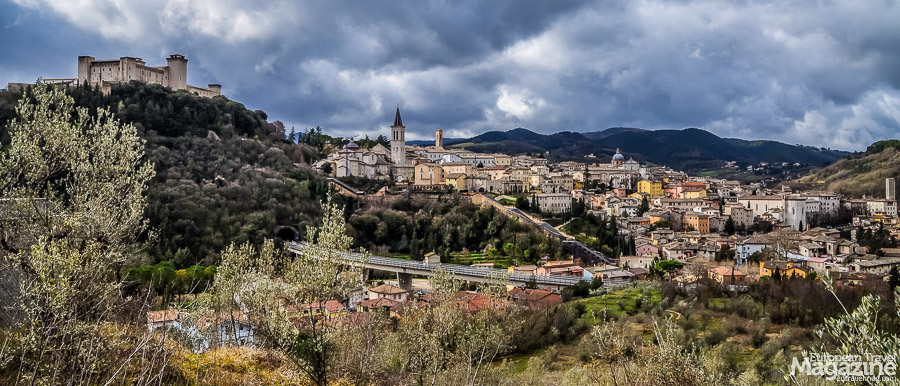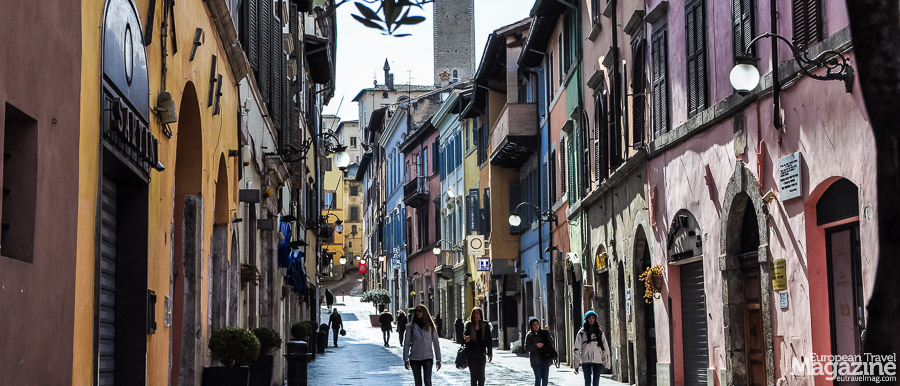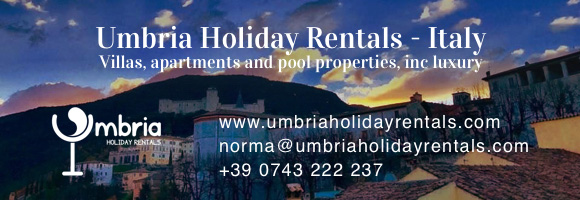Perugia may be the regional capital of Umbria, Assisi its spiritual centre but after one month of roaming the region, we must conclude that Spoleto is its crowning piece. As it sits enthroned above the Umbrian valley with its back to the hills of the south, it looks to the north, to the beautiful towns of Trevi, Montefalco, Spello, Assisi and Perugia.
But Spoleto has its own unique charm, the successful marriage of history and culture: a pedestrian city centre with inviting, cobblestoned streets, a history that spans over several millennia and a rich cultural scene.
Crowning jewels
Like many other hilltowns in Umbria, Spoleto offers a travellator, or moving walkway, that’ll take you from the (paid) parking garage Posterna in the lower part of town to the castle, that’s the very pinnacle of Spoleto. For free. From here, you can stroll down the streets until you reach the car park or take a shortcut via the many stations of the moving walkway. This system saves you time and energy and makes Spoleto a popular destination for all ages.
The castle that dominates the town, and indeed the whole valley, is Rocca Albornoziana. It was built in only 11 years in the 14th century by Cardinal Albornoz to re-affirm the authority of Pope Innocent VI in central Italy. The castle has a rectangular shape and was defended by six imposing towers. When it lost its protective purpose it was turned into a prison, and acted as such until 1982. Today it houses the Museum of the Duchy.
From the castle, take a stroll around it on the fabled and charming promenade Giro della Rocca that’ll afford you amazing views to the medieval aqueduct Ponte delle Torri, 80 metres tall, 230 metres long and probably built on the remains of a previous Roman structure. It was until recently used as a bridge to reach the green mountain of Monteluco on the other side, but has unfortunately been closed for safety reasons.
End your promenade at La Portella where a good-humoured Emiliano likes to chit chat while serving espresso or cappuccino. Enjoy the view of Monteluco and the green hills to the south.
Descend into medieval Spoleto. On your way down the pedestrian street you come upon the romanesque Cathedral of Santa Maria Assunta with its Renaissance portico to your right. As you look down onto the square and the beautiful cathedral that beams at its back, imagine it being filled with musicians, dancers, actors and, of course, a large audience. This is how you’ll find the square and rest of Spoleto every year for two weeks from late June to middle of July, when the city is tuned into backdrop for the internationally renowned Spoleto Festival Dei 2Mondi.
Continue down to your left and the alluring medieval alley pours out into Piazza del Mercato, a former Roman forum and now the beating heart of Spoleto, with cafés, restaurants, enotecas, gelaterias spilling out into the veins of the city. Especially Caffe’ Degli Artisti is popular with locals and invites to sit outside and take in the atmosphere.
A few steps down the street stands the Arch of Drusus from 23 AD, as it has for two millennia, marking the ancient entrance into the Roman forum. If you enter through this and turn right at the end of the street you’ll reach Piazza della Libertà. Peak through the bars of the doors towards the Roman Theatre, dating back to the 1st century BC and imagine this as a backdrop for dancers at the aforementioned Spoleto Festival Dei 2Mondi. Old and new meets and begets art.
Continue down the shopping street Corso G. Mazzini where you can go on a shopping spree in the various shops as well as the Tourist Office to your right. When you reach Piazza Mentana at the end of the pedestrian street, turn left down the flight of stairs to continue downhill through the charming cobblestone alleys of Via Minervio, Via Salara Vecchia and Via Porta Fuga. Here, you can really feel the ancient ambiance of Spoleto.
When you reach the cute looking restaurant 9Cento, you can either turn left to get back to the car park Posterna, or continue to explore yet another shopping street, Corso Giuseppe Garibaldi. The street opens up into Piazza Giuseppe Garibaldi, that’s always alive with traffic, italians having an espresso and ragazzi sitting on the Garibaldi monument keeping an eye out for handsome members of the opposite sex.
Umbri, Romans and Longobards
Spoleto appears to have been an important town to the ancient Umbri tribe, that even predate the Tuscan Etruscan civilization, and they built walls around their settlement in the 5th century BC, some of which are visible today. It was named Spoletium by the Romans who founded a colony here in 241 BC, and the industrious Romans are responsible for the many ancient monuments that bejewels the city.
The legendary Hannibal (with an unknown number of elephants) even tried to attack the city in 217 BC, but failed. When the Roman empire collapsed, Spoleto was – due to its strategic elevated position – conquered by both Visigoths and Byzantines for some years, before the germanic tribe of the Longobards gained control of the region and founded the Duchy of Spoleto in 570, with Spoleto as its capital. The Longobards didn’t leave many architectural remains behind, but the Basilica of San Salvatore in Spoleto and the nearby Tempietto del Clitunno are UNESCO World Heritage designated examples hereof.
After Charlemagne had kicked some Longobard butt, Spoleto became part of Holy Roman Empire in 774 but fought to regain its independence. In 1155 Spoleto was conquered and sacked by Frederick Barbarossa, and after a series of conflicts between the Guelfs and the Ghibellines, it was brought under the authority of the Papal States in 1354. Apart from a brief period under Napoleon, the papal rule continued unbroken until Spoleto joined the new Italian State in 1860.
What makes the history about Spoleto so fascinating is, that you can witness the course of time through its architecture. Parts of the defensive walls date all the way back to the Umbri tribes 500 BC. The Arch of Drusus from 23 AD is the oldest Roman remain, whereas the Basilica of San Salvatore in its present form was constructed by the Longobards in the 7th century. The Medieval ambiance is tangible in the historic centre of Spoleto and the architectural highlights of this period must be the 14th century Ponte delle Torri and Rocca Albornoziana.
The Renaissance is evident in the Cathedral’s 16th century portico while the beautiful Palazzo Collicola, which now houses an art museum, was completed in 1730 in the Baroque style. Everywhere you look, history looks back on you.
Cultural hotspot
Apart from the 4 times larger Perugia with its university and status as Umbria’s capital, Spoleto is the most lively and cultural of the cities in Umbria. The Spoleto Festival Dei 2Mondi is a spectacular display of opera, music, dance and theatre during the first two weeks of July. From the Roman theatre to Teatro Nuovo, from the Piazza Duomo to the Archbishop’s Palace, the ancient buildings and beautiful squares will come alive with performances.
During summertime, various events and concerts are held everywhere in the city, but the fact that important events take place outside the traditional tourist months, is proof that Spoleto is a lively city all year round. From the International Dance Competition in May to November, where the city hosts the Strumenti & Musica Festival with accordion and piano competitions. I’ll bet you’ll find something going on whenever you decide to visit.
Spoleto is the smallest cosmopolitan city I have ever visited. Filled with medieval ambiance, held alive with plenty of cultural events and surrounded by green hills and spectacular landscape, Spoleto offers the ideal vacation, the equilibrium between culture and nature. We spent a month and already want to go back and spend another!
To make Spoleto feel as homely as we did, we recommend renting an apartment through Norma at www.umbriaholidayrentals.com. As a british expat, she knows what is important for travellers, and her different apartments are tastefully decorated and uniquely located.
More info
- Spoleto Tourist Website
- SpoletoCard
- Spoleto on Umbria’s official Tourist Website
- Spoleto on Wikipedia
- Spoleto Festival Dei 2Mondi



















































